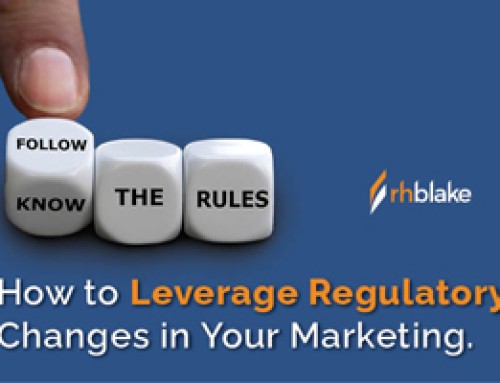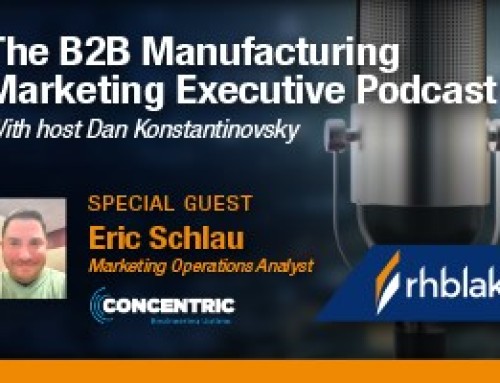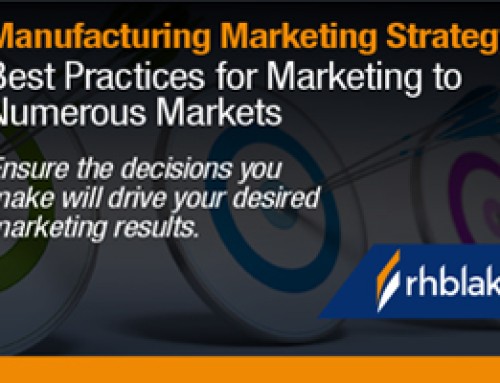How to Create the Perfect B2B Launch Presentation – Tips for Manufacturing Marketers
Written by Dan Konstantinovsky
Strategic Marketing, RH Blake
![]()
It’s staggering to think that 50 percent of product launches fail to achieve business objectives. That’s according to McKinsey.
There’s a myriad of reasons, including competing against more messages across more channels than ever. So it’s especially critical that once you’ve secured that one-on-one meeting with a prospect that you’re putting your best foot forward.
To do that, you need a well-crafted launch presentation. One that flows differently than you might expect.
Here are tips and a proven structure to create B2B launch presentations that resonate and generate interest faster. You can easily apply them to your next launch.
Tip 1: Flip your way of thinking
B2B manufacturing marketing is still plagued by companies talking about themselves first instead of the customers’ needs. That might seem acceptable for a launch because, after all, it is a product introduction.
How to Create the Perfect B2B Launch Presentation – Tips for Manufacturing Marketers
 Written by Dan Konstantinovsky
Written by Dan Konstantinovsky
Strategic Marketing, RH Blake
![]()
It’s staggering to think that 50 percent of product launches fail to achieve business objectives. That’s according to McKinsey.
There’s a myriad of reasons, including competing against more messages across more channels than ever. So it’s especially critical that once you’ve secured that one-on-one meeting with a prospect that you’re putting your best foot forward.
To do that, you need a well-crafted launch presentation. One that flows differently than you might expect.
Here are tips and a proven structure to create B2B launch presentations that resonate and generate interest faster. You can easily apply them to your next launch.
Tip 1: Flip your way of thinking
B2B manufacturing marketing is still plagued by companies talking about themselves first instead of the customers’ needs. That might seem acceptable for a launch because, after all, it is a product introduction.
However, that’s not true. You’re actually introducing a new or better way to solve a problem. You need to put the “Why” before the “How” and “What.”
Think of it as a variation of Simon Sinek’s famous Golden Circle—only applied to marketing instead of leadership.
However, that’s not true. You’re actually introducing a new or better way to solve a problem. You need to put the “Why” before the “How” and “What.”
Think of it as a variation of Simon Sinek’s famous Golden Circle—only applied to marketing instead of leadership.
First, focus on establishing why a customer should care: solve your [insert] problem.
Second, explain how you solve it.
Finally, share what the solution is that accomplishes it.
The customer-centric structure in tip 6 shares how to do this.
Tip 2: Put the time into message development
Messaging matters. We all know it, and yet because of time or resource constraints, marketing teams often don’t invest enough effort into creating compelling messages that establish relevancy, differentiation, clarity and urgency.
It’s hard, but vital work. Two tests that will help during the process are:
- Change out your company or product name for a competitor’s brand. Can they also make that claim?
- Ask yourself: why would the customer care? Be honest.
Do this repeatedly and refine until you have a message that stands out.
Tip 3: Pick the most compelling pain point
It’s best to lead with one pain point than to string several together. There will always be a desire with your internal teams to equally cover many pain points for fear that just one might not be the right one.
But if you do your homework, you will identify the one pain point that covers the majority of the audience. Use it. Because too many messages don’t make your presentation better; they make it harder to follow.
Tip 4: Gather ALL your proof points
Proof points are going to make your presentation stronger and the salesperson’s job easier. Collect everything you can and incorporate them into the story. Proof points can be:
- Lab test results
- Customer beta test results
- Use cases (point to uses cases blog when live)
- Case studies, if available
- Your company’s recognized success in the vertical or industry
Tip 5: Don’t be boring but do stay on brand
Follow your brand guidelines; however, don’t be afraid to bend them slightly if it helps communicate your story. There might be a useful metaphor or unusual image that conveys the impact of the solution. If so, use them professionally.
Other ways to avoid being boring are to use striking visuals, sharp, but concise copy, or simple charts. Remember, lots of copy and bullet points are dull.
Tip 6: Use a customer-centric structure
Here’s our preferred presentation flow. We’ve created variations for our clients’ launches, and have refined it over time. It’s three main sections, made up of several subject slides. I think you’ll find it easy to follow.
Keep in mind that there is not a “right” number of slides. However, each should be very focused and not overstuffed with specifications and details that are better residing in another format. Stick to the essentials.
Title Slide
- Include a statement about addressing the customer’s pain point
- Visuals here should relate more to the customer issue. A small inset photo of the product will suffice.
Customer Pain Point Section: the “why” hook
- Grab the audience’s attention with a real-world example or the core problem to be addressed. Build on that with details such as:
- The cost of improperly addressing the issue
- Shortcomings with traditional ways to address, including the remaining risk and costs
- Market trends that require a solution in order to remain competitive
- What could the future look like if you solved the problem?
Solution Section: the “how” and “what” explanation
- How we address the problem
- Now name and explain the solution
- Use cases that touch on the ways the solution helps the prospect’s business
- How the solution addresses concerns or impacts the roles of decision-makers and team members
- Features
- Benefits
- Case studies, such as customer beta test results
Why Us Section: establish validity
You’ve delivered a compelling case for your solution approach, now build on that with details than demonstrate the credibility of your business.
Summary and Close
- Summarize the problem(s) solved
- State the call-to-action if applicable, such as a demo, trial or assessment
- Provide access to more information to increase engagement
Tip 7: Involve the sales team in development
Your sales team should be an active member of the product launch team. The more involved they can be, the better. That is especially true with the presentation. It’s one of their core sales tools. The more they help create the story, the more successful they’ll be presenting it.
Use this template for your next presentation
There’s a lot that goes into a successful launch. While the sales presentation is just one component, it’s a key one. Your efforts to build the most compelling, customer-centric story will pay dividends.
To get a head start, we invite you to request this PowerPoint template. It’s the core structure our clients have had success with.
First, focus on establishing why a customer should care: solve your [insert] problem.
Second, explain how you solve it.
Finally, share what the solution is that accomplishes it.
The customer-centric structure in tip 6 shares how to do this.
Tip 2: Put the time into message development
Messaging matters. We all know it, and yet because of time or resource constraints, marketing teams often don’t invest enough effort into creating compelling messages that establish relevancy, differentiation, clarity and urgency.
It’s hard, but vital work. Two tests that will help during the process are:
- Change out your company or product name for a competitor’s brand. Can they also make that claim?
- Ask yourself: why would the customer care? Be honest.
Do this repeatedly and refine until you have a message that stands out.
Tip 3: Pick the most compelling pain point
It’s best to lead with one pain point than to string several together. There will always be a desire with your internal teams to equally cover many pain points for fear that just one might not be the right one.
But if you do your homework, you will identify the one pain point that covers the majority of the audience. Use it. Because too many messages don’t make your presentation better; they make it harder to follow.
Tip 4: Gather ALL your proof points
Proof points are going to make your presentation stronger and the salesperson’s job easier. Collect everything you can and incorporate them into the story. Proof points can be:
- Lab test results
- Customer beta test results
- Use cases (point to uses cases blog when live)
- Case studies, if available
- Your company’s recognized success in the vertical or industry
Tip 5: Don’t be boring but do stay on brand
Follow your brand guidelines; however, don’t be afraid to bend them slightly if it helps communicate your story. There might be a useful metaphor or unusual image that conveys the impact of the solution. If so, use them professionally.
Other ways to avoid being boring are to use striking visuals, sharp, but concise copy, or simple charts. Remember, lots of copy and bullet points are dull.
Tip 6: Use a customer-centric structure
Here’s our preferred presentation flow. We’ve created variations for our clients’ launches, and have refined it over time. It’s three main sections, made up of several subject slides. I think you’ll find it easy to follow.
Keep in mind that there is not a “right” number of slides. However, each should be very focused and not overstuffed with specifications and details that are better residing in another format. Stick to the essentials.
Title Slide
- Include a statement about addressing the customer’s pain point
- Visuals here should relate more to the customer issue. A small inset photo of the product will suffice.
Customer Pain Point Section: the “why” hook
- Grab the audience’s attention with a real-world example or the core problem to be addressed. Build on that with details such as:
- The cost of improperly addressing the issue
- Shortcomings with traditional ways to address, including the remaining risk and costs
- Market trends that require a solution in order to remain competitive
- What could the future look like if you solved the problem?
Solution Section: the “how” and “what” explanation
- How we address the problem
- Now name and explain the solution
- Use cases that touch on the ways the solution helps the prospect’s business
- How the solution addresses concerns or impacts the roles of decision-makers and team members
- Features
- Benefits
- Case studies, such as customer beta test results
Why Us Section: establish validity
You’ve delivered a compelling case for your solution approach, now build on that with details than demonstrate the credibility of your business.
Summary and Close
- Summarize the problem(s) solved
- State the call-to-action if applicable, such as a demo, trial or assessment
- Provide access to more information to increase engagement
Tip 7: Involve the sales team in development
Your sales team should be an active member of the product launch team. The more involved they can be, the better. That is especially true with the presentation. It’s one of their core sales tools. The more they help create the story, the more successful they’ll be presenting it.
Use this template for your next presentation
There’s a lot that goes into a successful launch. While the sales presentation is just one component, it’s a key one. Your efforts to build the most compelling, customer-centric story will pay dividends.
To get a head start, we invite you to request this PowerPoint template. It’s the core structure our clients have had success with.







